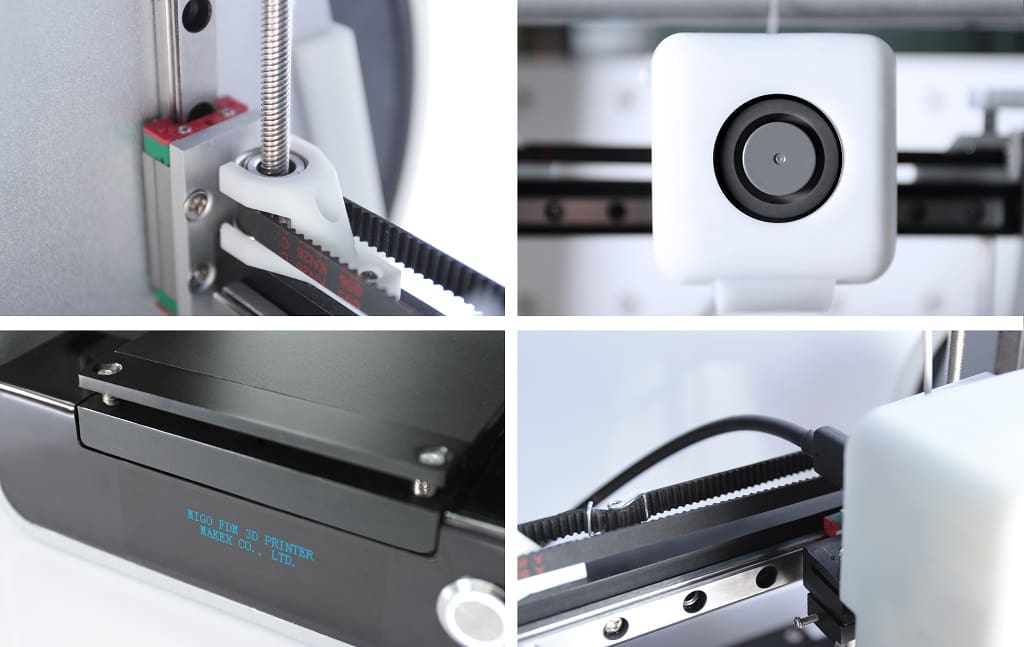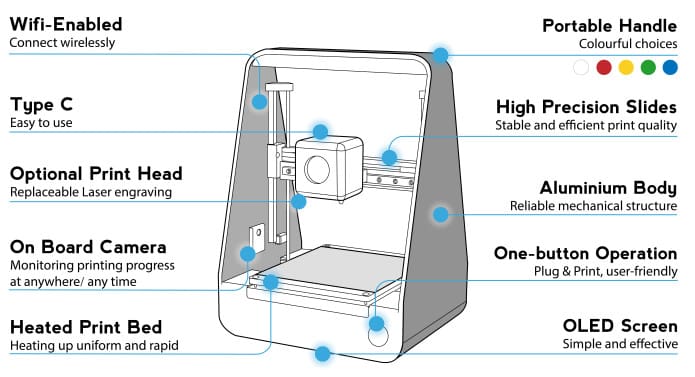The portable Migo 3D printer is a crowdfunding success story, raising $156,967 from 556 backers in December 2017 on Kickstarter.
The printer is available in two sizes, the Migo and the Migo L. The standard model has a build volume of 100 x 120 x 100 mm, while the latter offers an increased build volume of 150 x 150 x 150 mm. Aside from this difference in size, it has the exact same functionality (but is marginally less portable).
Units are scheduled to be begin delivery to select backers in March 2018. Anticipation is very high for the Migo 3D printer, so we’ve pulled together all the features and technical specs in one place for a handy reference guide.
And despite the campaign’s conclusion, preorders are still open for the Migo 3D printer over on Indiegogo. The base package is still available for the price of $279, which is 42% off the eventual retail price.
For an additional $100, the Migo L base package is available for $379. Thereafter, pledges can be scaled up for additional extras.
Review the Features

Key to the appeal of the Migo 3D printer is the compact design, where the unit is enclosed in a single piece aluminum frame. It’s small, cute, and very easy to pick up with one hand.
Another topline feature is the wireless connectivity, where the printer can be controlled over your local wireless network. Paired with the onboard camera, you can easily monitor the status of your print job from afar.
Next is the auto-levelling build platform, which makes calibration of your print-bed more straightforward than having to do it manually. It also uses PEI sheets for enhanced bed adhesion. For a 3D printer in this price bracket, both are useful features to have.
Finally, you can easily swap the 3D printing module for a laser-engraving module. This is an optional extra for the platform, but it’s worth investing in for the additional functionality it provides.
Overall management of the printer is handled by the X-Maker software, which is compatible with Windows, Mac, and Linux operating systems. And USB-C cables provide next-gen connectivity and power options.
Small Enough to Fit into a Backpack

But wait! There’s more! The default version of the Migo has one very special optional extra; a 3D printing backpack.
The MakeX Migo backpack lets you carry the ultra-small 3D printer anywhere you need to go. And it’s not just a static transport option. If you hook it up to a portable power source, it can also fabricate objects on the move.
It’s a good test of the auto-levelling function of the 3D printer, to be sure. That, and the ability to monitor the Migo wirelessly from your phone. But the size of the objects being printed have an additional limitation to the build volume; the battery on the printer need to run for long enough to finish the job.
The 3D printer is encased in a hard plastic shell and is completely transparent. It’s a $70 accessory, and if your chief priority with the Migo is for complete portability and flexibility, then the backpack seems like a good way to go.
Check it out in the time-lapse video below:
Review the Technical Specifications

3D Printer (Standard Size)
- Technology: FDM
- Materials: PLA, ABS
- Filament Diameter: 1.75 mm
- Compatible with Third Party Material: Yes
- Build Volume: 100 x 120 x 100 mm
- Maximum Print Speed: 100 mm/s
- Minimum Layer Thickness: 50 microns
- Nozzle Diameter: 0.4 mm
- Heated Bed: Yes
- Onboard Controls: LCD Screen
- Connectivity: Wi-Fi, USB
- Onboard Camera: Yes
- Open Source Hardware & Software: No
Laser Engraver (Standard Size)
- Work Area: 100 x 102 mm
- Maximum Power: 1000 mW
- Wavelength: 405 nm
- File Formats: JPG, PNG, DXF, PDF, AI
License: The text of "Portable Migo 3D Printer: Review the Facts Here" by All3DP is licensed under a Creative Commons Attribution 4.0 International License.